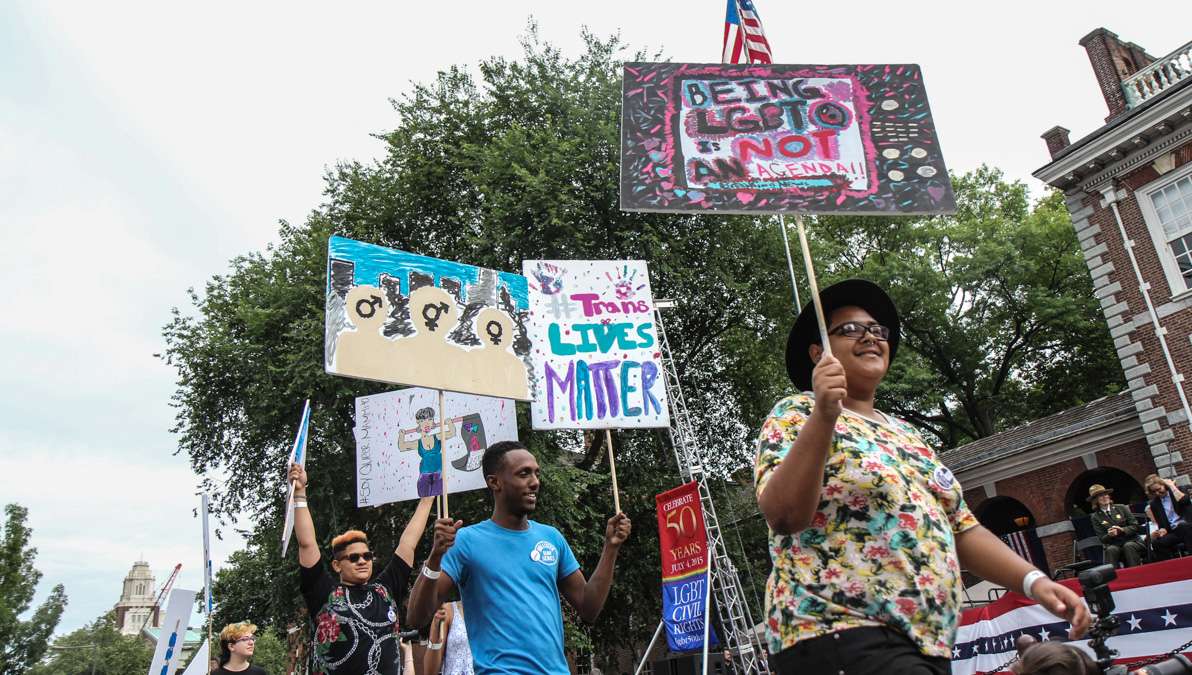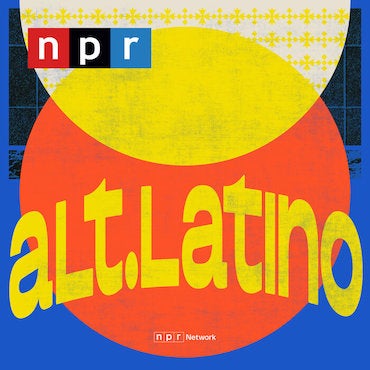In celebrating Philly LGBT history, the ‘T’ is silent — and that’s not all

LGBT youth picket for rights and understanding at Philadelphia's July 4 celebration of the 50th anniversary of the gay rights movement. (Kimberly Paynter/WHYY)
Standing at Independence Hall on July 4, 2015, Philadelphia Mayor Michael Nutter referred to the date as the 50th anniversary of the LGBT Rights Movement. Equality Forum promotes the Annual Reminders demonstrations as the foundation of the LGBT movement. “Speaking Out for Equality: The Constitution, Gay Rights and the Supreme Court” at the National Constitution Center also refers to the Annual Reminders as the beginning of the LGBT movement.
None of this is true.
The transgender movement, the “T” in LGBT, happened in spite of, not because of, the gay rights movement. July 4, 1965, was the official beginning of lesbian and gay activists excluding transgender and gender non-conforming people from the movement.
A history of exclusion
Pride has become a business with corporate sponsorship, and “LGBT” is the trademark acronym, so it became easy for people to conflate the gay rights movement of 50 years ago with the so-called LGBT movement of today. For many transgender and gender non-conforming people, July 4 is an annual reminder of their exclusion. To participate in the Annual Reminders demonstrations of the ’60s, women had to wear dresses, and men had to wear shirts, ties and pants. No expression of gender non-conformity was allowed. So to claim that this was the start of an LGBT movement is fraudulent. It is like saying conservative activist Phyllis Schafly is the mother of modern feminism.
Several months before the 1965 protest on Independence Mall, a multi-racial group of drag queens, gender non-conforming people and their friends held a five-day sit-in demonstration at the Dewey’s at 17th and Chancellor to protest their not being served there. Why are the Annual Reminders, and not the Dewey’s sit-in, being held up as the beginning of the LGBT movement? How does it make sense that a group that discriminated against transgender people is responsible for the transgender movement?
While it is common knowledge that street drag queens and transgender people participated in the Stonewall Riots in New York City, transgender people were almost immediately pushed out of gay liberation. Sylvia Rivera, a Stonewall veteran and founder of Street Transvestites Action Revolutionaries left Gay Activists Alliance after GAA eliminated the rights of transgender people from its agenda.
When Jennicet Gutiérrez, at great risk to herself as an undocumented transgender woman, heckled President Obama about undocumented transgender women being held in detention with men, being raped and otherwise abused, it was reminiscent of the time Rivera took over the microphone at the 1973 Christopher Street Liberation Rally and screamed about drag queens and transsexual women being raped in prison.
The first two platforms for the Marches on Washington for Lesbian and Gay Rights (1979 and 1987) excluded transgender people.
During the planning meeting for the first march, activist Walter Lear discussed with a lesbian in front of me why gender identity shouldn’t be included. He said, “We don’t have to worry about the rights of transvestites, because 90 percent of transvestites are straight!” I couldn’t get a word in edgewise.
Hostility and harassment
It became common for some lesbian women, very often highly educated and privileged, to accuse transgender women (who suffer the highest rates of discrimination and hate crime violence) of oppressing them. To this day, trans-exclusionary radical feminists (TERFs) harass transgender people, including notifying their employers, interfering with medical care, keeping transgender people from access to bathrooms appropriate to their gender (this includes transgender children in schools), and even protesting transgender human rights at the UN.
These people have colluded with far-right groups and at one time worked with the Reagan administration to remove transgender coverage from Medicaid, Medicare and health insurance. The lesbian and gay communities have been largely silent about this.
“The Transsexual Empire” by Janice Raymond is a paranoid book that claimed transsexual* women were an invention of the patriarchy to infiltrate and replace cisgender women. This became the bible of the TERF movement.
*”Transsexual” is an older term for people who have gender dysphoria, need to live as the gender that does not correspond with their birth sex, and may have sex reassignment surgery. “Transgender” describes anyone who does not fix exactly into the male/female binary gender. “Cisgender” describes someone who lives as the gender they were assigned at birth.
Gay men have frequently harassed transgender women. It happened to me often, with gay men calling me “he” and “him” and using my childhood name. Gay male writers such as John Mitzel frequently wrote about transsexuals “mutilating” themselves.
The Human Rights Campaign, formerly Human Rights Campaign Fund, spent 15 years fighting transgender inclusion in the Employment Non-Discrimination Act, with former executive director Elizabeth Birch saying that gender identity would be included over her dead body. Former U.S. Rep. Barney Frank claimed that transgender people were trying to piggyback on lesbians and gays, and he repeatedly talked about penises in women’s showers. In the mid ’90s there was a scandal when HRC had transgender-inclusive language removed from ENDA. In 2007, it seemed that HRC and Frank had acquiesced to allow gender identity in ENDA. An ENDA bill that included gender identity was introduced to committee. Frank took it out again, causing a fractious schism within the LGBT communities.
The Philadelphia Fair Practices Act (Bill 1358) of 1982 excluded transgender people. The Philadelphia domestic partnership bills of 1998 excluded transgender people.
I have been writing about the murders of transgender women for 30 years. The many murders of those women never received the kind of sympathetic reaction, with politicians creating hate crimes legislation, that the assault of two gay white men in Center City did last fall.
In 1987, Anthony Milano, a white gay man from Levittown, was murdered in Bristol Township. Philadelphia Magazine wrote a sensitive article about the ensuing trial. When Tanya Moore and Tina Rodriguez, transgender women of color, were murdered in 1986, their bodies cut up and set on fire, Philadelphia Magazine published a lurid article that suggested they deserved to die.
History repeating
That brings us to the “50th anniversary” of our big happy dysfunctional family. The banner on Equality Forum’s website states “Advancing LGBT Rights.” It also proclaims July 4, 2015, as the 50th anniversary of the LGBT Civil Rights Movement. Yet, there were no transgender presenters listed on the Equality Forum schedule and no transgender-specific programming.
Equally bad and very telling, there were not even any lesbians on the legal panel, which consisted of five white men and apparently one Latino man. No women at all. How can transgender and lesbian issues be represented when transgender and lesbian people are not represented? This points to lack of diversity that permeates the Equality Forum and the Constitution Center’s exhibit.
“Speaking Out for Equality” skims over LGBT history and ignores the many issues and complications of merging class, race, gender and gender identity into one movement. Lesbian feminism isn’t represented. Black gays and lesbians having to organize their own groups, publications, and pride events because they were ignored in mainstream LGBT groups isn’t represented. Transgender organizations are not represented. The Center presents a very shallow view of LGBT history.
The exhibit focuses heavily on the Annual Reminders — photos, interviews, ephemera such as Barbara Gittings’ dress. They dance around the earlier sit-in demonstration at Dewey’s with a quotation from a newspaper: “Homosexuals and persons wearing non-conformist clothes began a five-day sit-in at Dewey’s coffee shop.”
The Center’s website states that the Annual Reminders protest on July 4, 1965, “was intended to demonstrate that LGBT people were entitled to constitutional protection, and in their view, the demonstrators felt they were not being treated equally under the law.” But that’s not true. The organizers had no intention of letting transgender people participate, nor any interest in transgender civil rights.
In fact, the exhibition states: “Protest organizers (Barbara Gittings, Frank Kameny and others) instituted strict rules, including a conservative dress code. Because they knew that most people saw homosexuals as deviants, they wanted to appear ‘normal.’ That way, they reasoned, attention would be on their picket signs, not them.”
Apparently they thought transgender and gender non-conforming people were deviant.
Transgender people do not come up in the exhibit until after 1965: “In the summer of 1966 rebellion erupts at Compton’s Cafeteria in San Francisco when trans patrons retaliate against the frequent harassment of drag queens.” Stonewall is mentioned, of course, but nothing about Sylvia Rivera or Marsha P. Mason.
There is a picture of Rachel Harlow, a famous transsexual woman from the ’60s, next to a copy of TV World Magazine with Liberace shown on the cover on top of a black-and-white television showing the 1967 CBS documentary “The Homosexuals.” Ridiculously, no explanation is given of who Rachel Harlow is. (She appeared in the 1967 documentary “The Queen.” She was also an actress and fashion model, and she fronted a fashionable eponymous Bank Street club.)
I had forgotten how pretty she was.
There is a Leslie Feinberg quotation about being butch in high school in the ’50s from “Transgender Warriors” (1997). There is no mention of Joe Beam, a black writer and editor from Philadelphia who in the ’80s edited “In the Life” the first anthology of African-American gay male writing.
Isaak Wolfe a white transgender boy who tried to be king of his senior prom in 2013 is in the exhibit. However, not presented is the black teenage transgender girl who sued DHS and the Youth Study Center because, despite being diagnosed with gender dysphoria, she was housed with boys and harassed physically, sexually and verbally. The City of Philadelphia settled.
There is a sign about a 2012 Equal Employment Opportunity Commission decision that discrimination against transgender people is discrimination based on sex.
In a media exhibit there is a poster from the Hilary Swank film “Boys Don’t Cry.” A video screen showed clips from the Netflix series “Orange is the New Black,” Unique, a character from Fox’s “Glee” singing “If I Were a Boy,” and the Amazon series “Transparent.”
It isn’t that transgender people did not participate in the LGBT movement. We frequently worked for lesbian and gay rights. What we received in return was constant scrutiny, insults and questions about whether we should be aligned with lesbians and gays. For example, in 1973 Radical Queens, a group I co-founded (with Tommi Avicolli Mecca) held the first benefit for the Gay Community Center, now called the William Way LGBT Community Center. In the mid-’90s the Center had to decide whether transgender people were part of the community. They eventually decided that we were, but it stings that the question was even taken seriously. A William Way board member told me that, to his knowledge, there are no transgender members on the board. William Way Executive Director Chris Bartlett told me that there are no transgender employees at the LGBT community center.
On July 24 “Defiant Archives: Trans Histories of Existence, Resistance and Brilliance,” will open at William Way. The exhibition about the history of transgender activism in Philadelphia, curated by transgender people, will supply a historical perspective sorely missing from the common understanding of LGBT history.
WHYY is your source for fact-based, in-depth journalism and information. As a nonprofit organization, we rely on financial support from readers like you. Please give today.

